Effect of Heat Treatment and Processing Methods on Material Properties
VerifiedAdded on 2023/06/12
|16
|3438
|89
AI Summary
This article discusses the effect of heat treatment and processing methods on material properties, the effect of directional lay of fiber on product properties, and identifies materials for spark plug parts. It also covers the detrimental effects of lack of careful control during manufacturing processes.
Contribute Materials
Your contribution can guide someone’s learning journey. Share your
documents today.
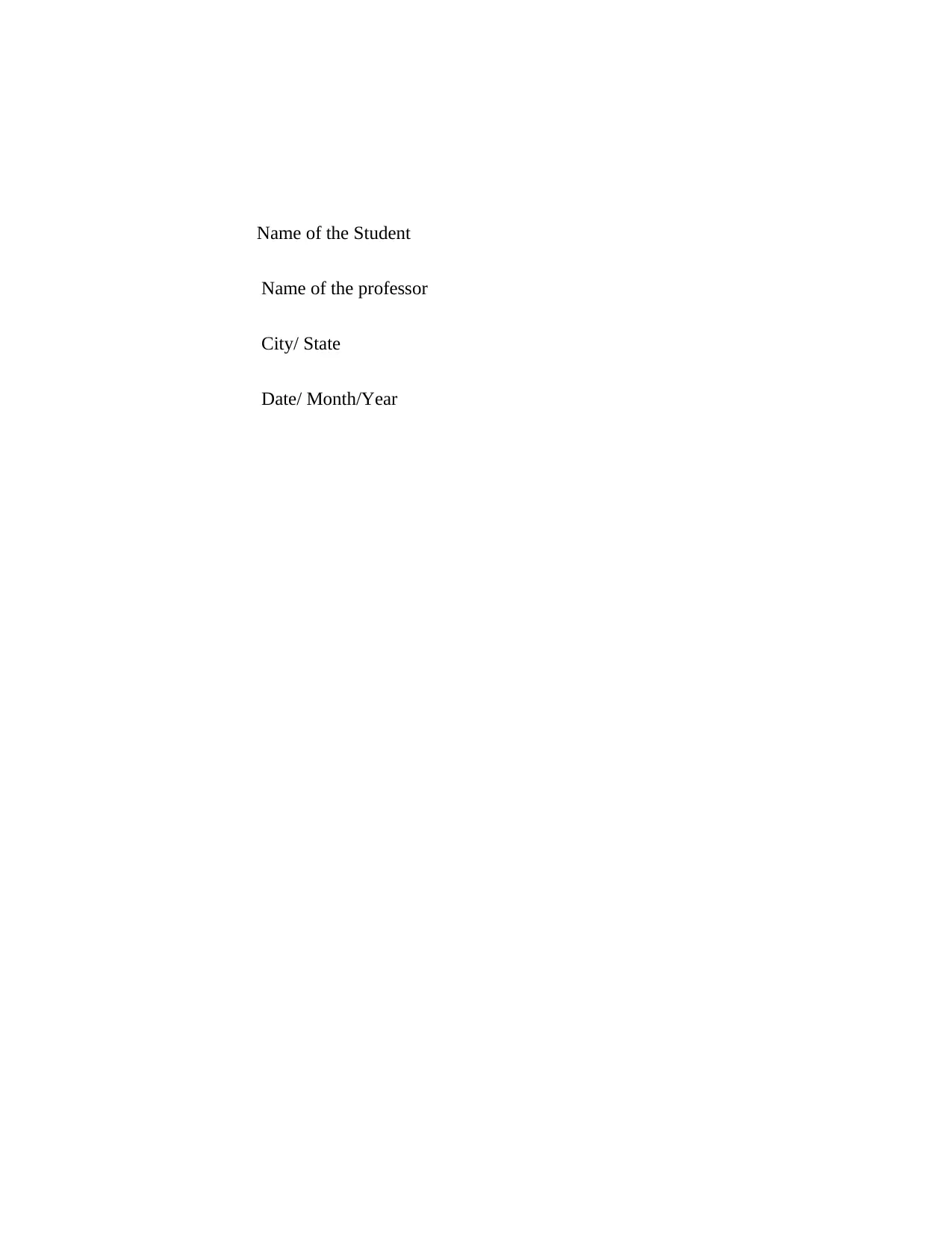
Name of the Student
Name of the professor
City/ State
Date/ Month/Year
Name of the professor
City/ State
Date/ Month/Year
Secure Best Marks with AI Grader
Need help grading? Try our AI Grader for instant feedback on your assignments.
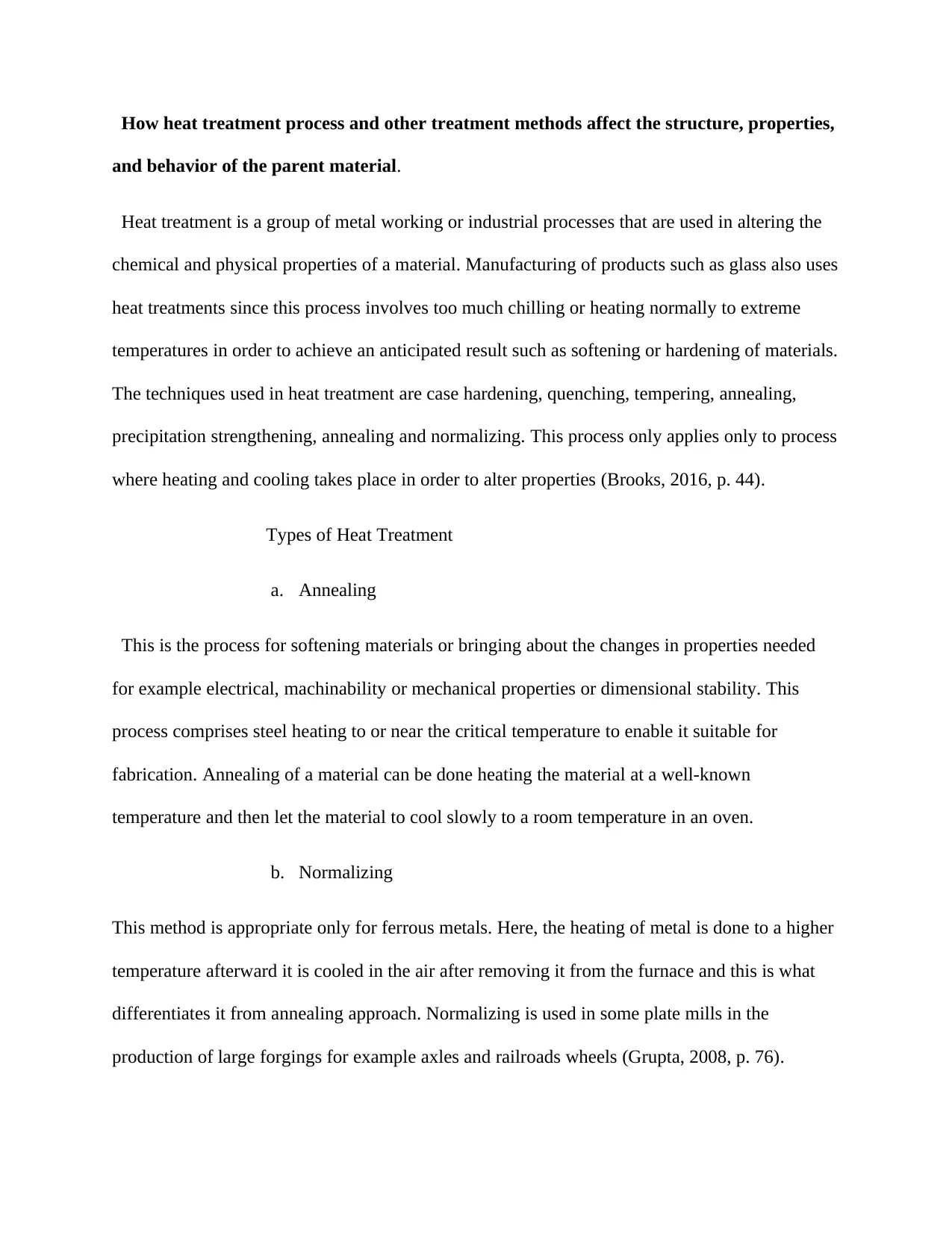
How heat treatment process and other treatment methods affect the structure, properties,
and behavior of the parent material.
Heat treatment is a group of metal working or industrial processes that are used in altering the
chemical and physical properties of a material. Manufacturing of products such as glass also uses
heat treatments since this process involves too much chilling or heating normally to extreme
temperatures in order to achieve an anticipated result such as softening or hardening of materials.
The techniques used in heat treatment are case hardening, quenching, tempering, annealing,
precipitation strengthening, annealing and normalizing. This process only applies only to process
where heating and cooling takes place in order to alter properties (Brooks, 2016, p. 44).
Types of Heat Treatment
a. Annealing
This is the process for softening materials or bringing about the changes in properties needed
for example electrical, machinability or mechanical properties or dimensional stability. This
process comprises steel heating to or near the critical temperature to enable it suitable for
fabrication. Annealing of a material can be done heating the material at a well-known
temperature and then let the material to cool slowly to a room temperature in an oven.
b. Normalizing
This method is appropriate only for ferrous metals. Here, the heating of metal is done to a higher
temperature afterward it is cooled in the air after removing it from the furnace and this is what
differentiates it from annealing approach. Normalizing is used in some plate mills in the
production of large forgings for example axles and railroads wheels (Grupta, 2008, p. 76).
and behavior of the parent material.
Heat treatment is a group of metal working or industrial processes that are used in altering the
chemical and physical properties of a material. Manufacturing of products such as glass also uses
heat treatments since this process involves too much chilling or heating normally to extreme
temperatures in order to achieve an anticipated result such as softening or hardening of materials.
The techniques used in heat treatment are case hardening, quenching, tempering, annealing,
precipitation strengthening, annealing and normalizing. This process only applies only to process
where heating and cooling takes place in order to alter properties (Brooks, 2016, p. 44).
Types of Heat Treatment
a. Annealing
This is the process for softening materials or bringing about the changes in properties needed
for example electrical, machinability or mechanical properties or dimensional stability. This
process comprises steel heating to or near the critical temperature to enable it suitable for
fabrication. Annealing of a material can be done heating the material at a well-known
temperature and then let the material to cool slowly to a room temperature in an oven.
b. Normalizing
This method is appropriate only for ferrous metals. Here, the heating of metal is done to a higher
temperature afterward it is cooled in the air after removing it from the furnace and this is what
differentiates it from annealing approach. Normalizing is used in some plate mills in the
production of large forgings for example axles and railroads wheels (Grupta, 2008, p. 76).
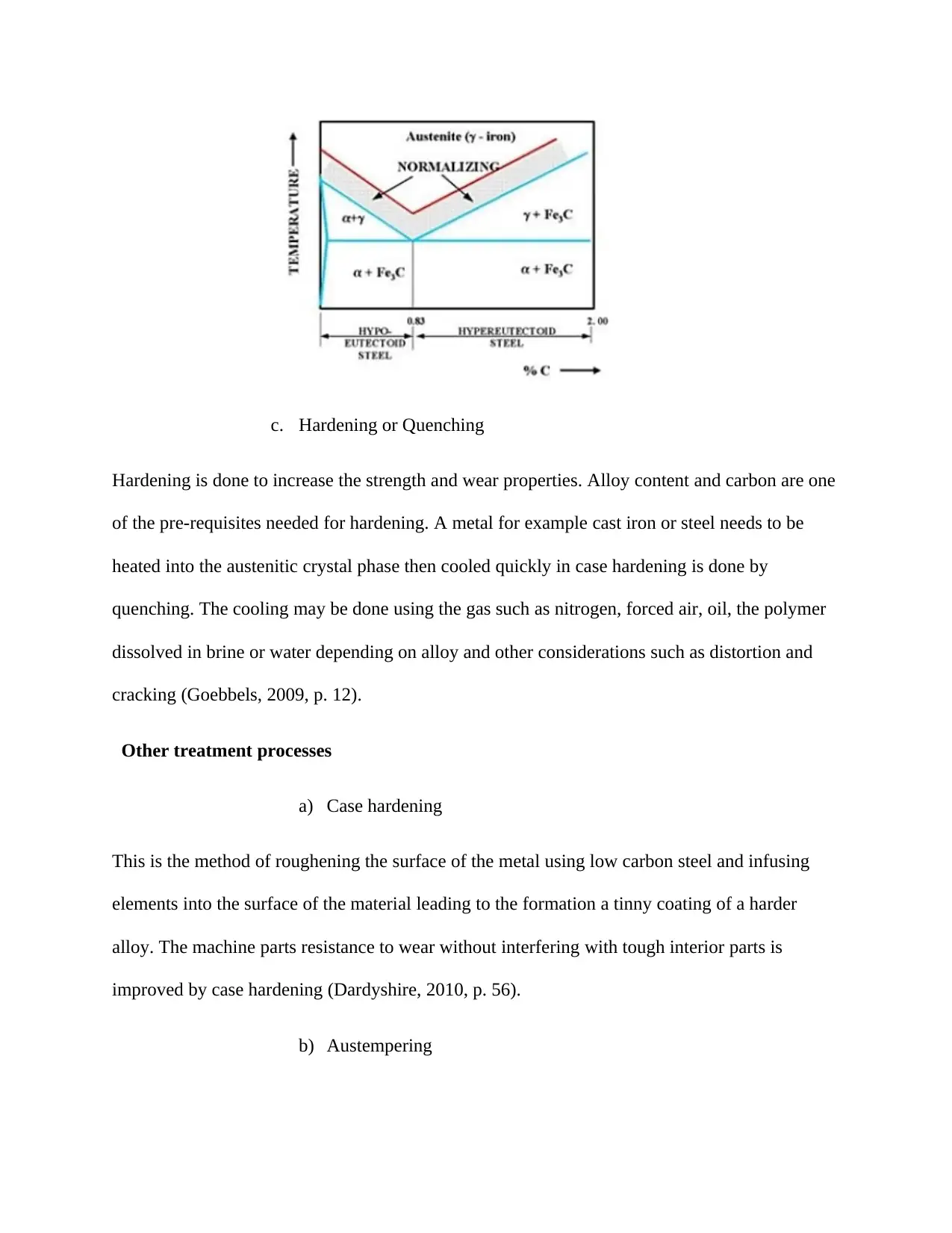
c. Hardening or Quenching
Hardening is done to increase the strength and wear properties. Alloy content and carbon are one
of the pre-requisites needed for hardening. A metal for example cast iron or steel needs to be
heated into the austenitic crystal phase then cooled quickly in case hardening is done by
quenching. The cooling may be done using the gas such as nitrogen, forced air, oil, the polymer
dissolved in brine or water depending on alloy and other considerations such as distortion and
cracking (Goebbels, 2009, p. 12).
Other treatment processes
a) Case hardening
This is the method of roughening the surface of the metal using low carbon steel and infusing
elements into the surface of the material leading to the formation a tinny coating of a harder
alloy. The machine parts resistance to wear without interfering with tough interior parts is
improved by case hardening (Dardyshire, 2010, p. 56).
b) Austempering
Hardening is done to increase the strength and wear properties. Alloy content and carbon are one
of the pre-requisites needed for hardening. A metal for example cast iron or steel needs to be
heated into the austenitic crystal phase then cooled quickly in case hardening is done by
quenching. The cooling may be done using the gas such as nitrogen, forced air, oil, the polymer
dissolved in brine or water depending on alloy and other considerations such as distortion and
cracking (Goebbels, 2009, p. 12).
Other treatment processes
a) Case hardening
This is the method of roughening the surface of the metal using low carbon steel and infusing
elements into the surface of the material leading to the formation a tinny coating of a harder
alloy. The machine parts resistance to wear without interfering with tough interior parts is
improved by case hardening (Dardyshire, 2010, p. 56).
b) Austempering
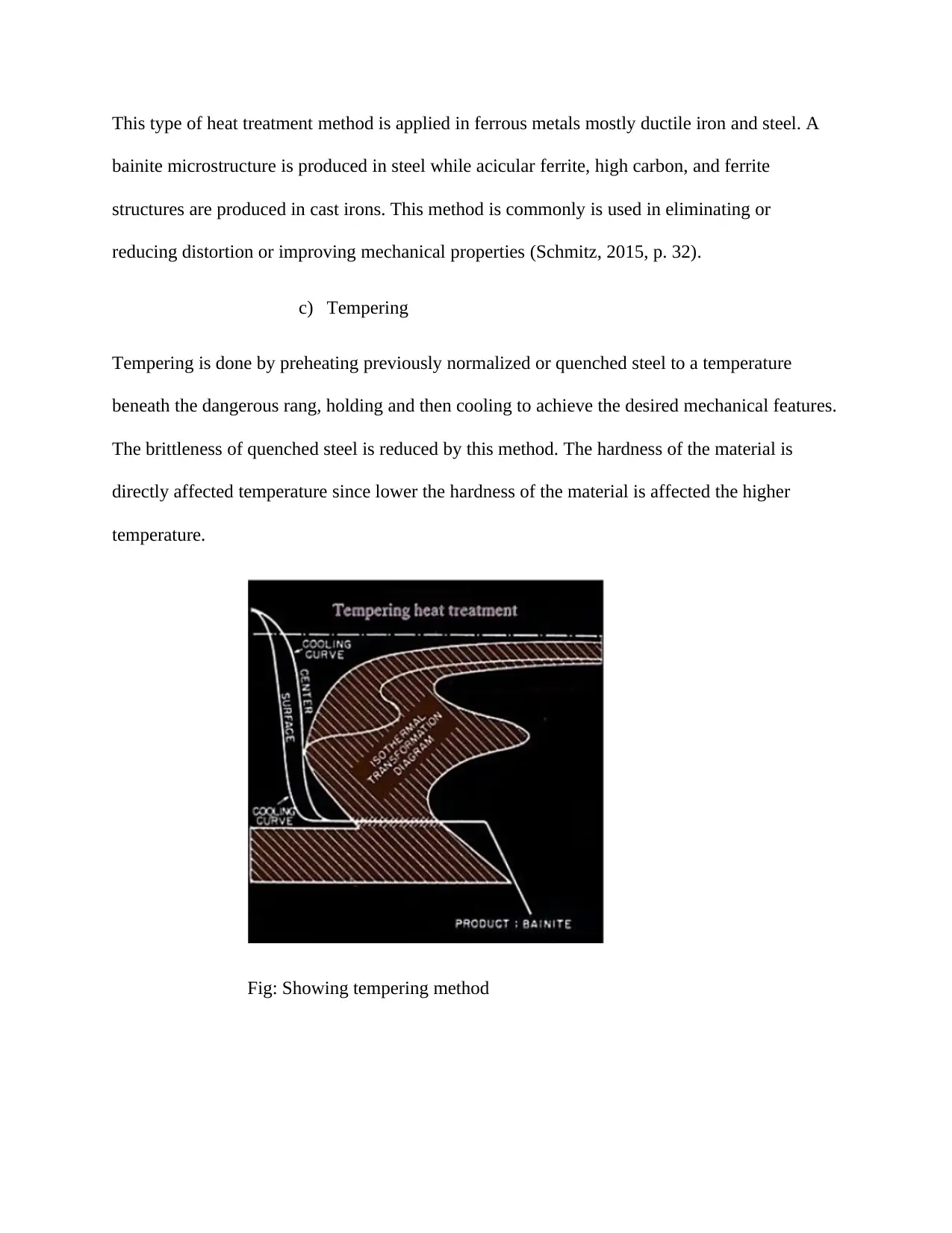
This type of heat treatment method is applied in ferrous metals mostly ductile iron and steel. A
bainite microstructure is produced in steel while acicular ferrite, high carbon, and ferrite
structures are produced in cast irons. This method is commonly is used in eliminating or
reducing distortion or improving mechanical properties (Schmitz, 2015, p. 32).
c) Tempering
Tempering is done by preheating previously normalized or quenched steel to a temperature
beneath the dangerous rang, holding and then cooling to achieve the desired mechanical features.
The brittleness of quenched steel is reduced by this method. The hardness of the material is
directly affected temperature since lower the hardness of the material is affected the higher
temperature.
Fig: Showing tempering method
bainite microstructure is produced in steel while acicular ferrite, high carbon, and ferrite
structures are produced in cast irons. This method is commonly is used in eliminating or
reducing distortion or improving mechanical properties (Schmitz, 2015, p. 32).
c) Tempering
Tempering is done by preheating previously normalized or quenched steel to a temperature
beneath the dangerous rang, holding and then cooling to achieve the desired mechanical features.
The brittleness of quenched steel is reduced by this method. The hardness of the material is
directly affected temperature since lower the hardness of the material is affected the higher
temperature.
Fig: Showing tempering method
Secure Best Marks with AI Grader
Need help grading? Try our AI Grader for instant feedback on your assignments.
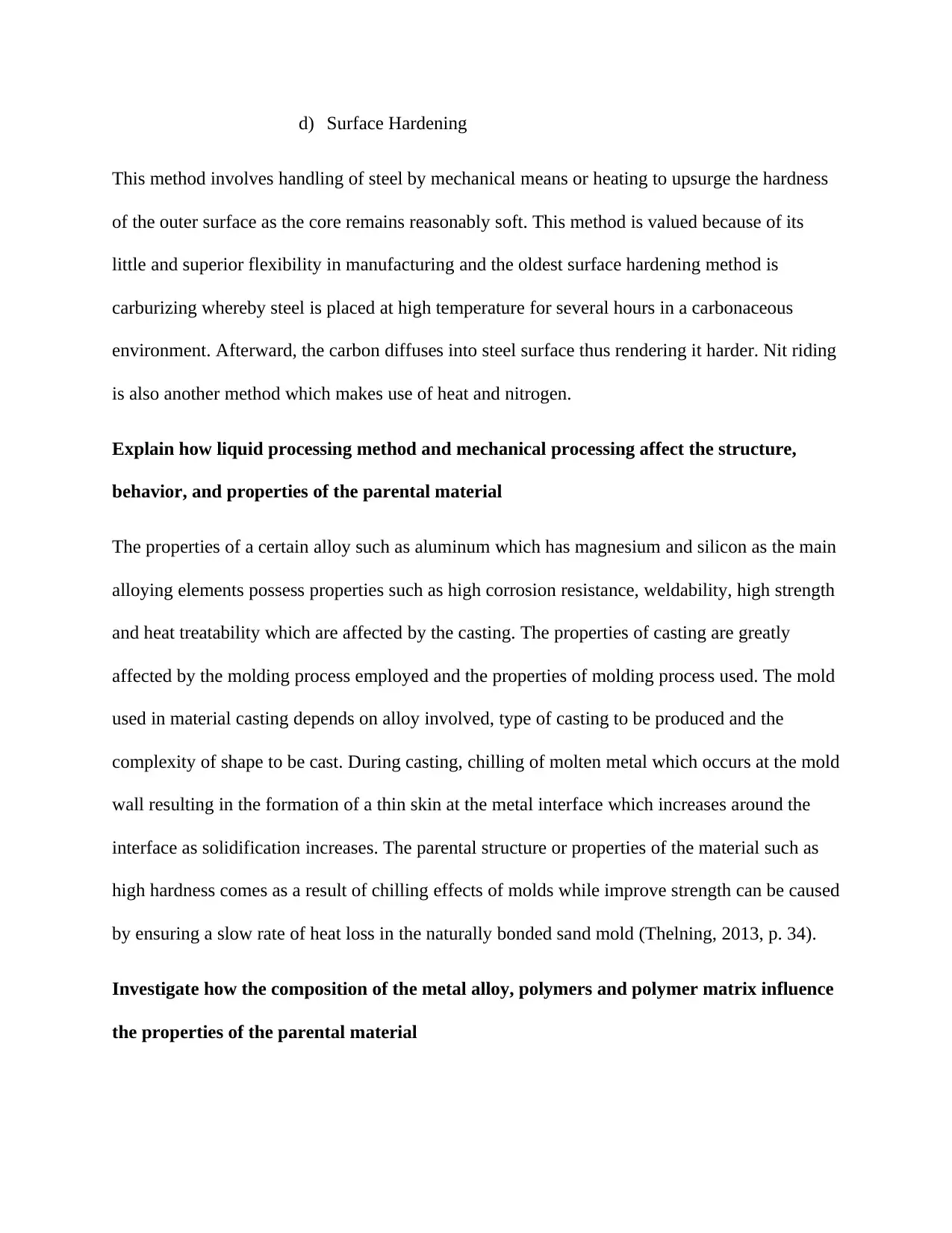
d) Surface Hardening
This method involves handling of steel by mechanical means or heating to upsurge the hardness
of the outer surface as the core remains reasonably soft. This method is valued because of its
little and superior flexibility in manufacturing and the oldest surface hardening method is
carburizing whereby steel is placed at high temperature for several hours in a carbonaceous
environment. Afterward, the carbon diffuses into steel surface thus rendering it harder. Nit riding
is also another method which makes use of heat and nitrogen.
Explain how liquid processing method and mechanical processing affect the structure,
behavior, and properties of the parental material
The properties of a certain alloy such as aluminum which has magnesium and silicon as the main
alloying elements possess properties such as high corrosion resistance, weldability, high strength
and heat treatability which are affected by the casting. The properties of casting are greatly
affected by the molding process employed and the properties of molding process used. The mold
used in material casting depends on alloy involved, type of casting to be produced and the
complexity of shape to be cast. During casting, chilling of molten metal which occurs at the mold
wall resulting in the formation of a thin skin at the metal interface which increases around the
interface as solidification increases. The parental structure or properties of the material such as
high hardness comes as a result of chilling effects of molds while improve strength can be caused
by ensuring a slow rate of heat loss in the naturally bonded sand mold (Thelning, 2013, p. 34).
Investigate how the composition of the metal alloy, polymers and polymer matrix influence
the properties of the parental material
This method involves handling of steel by mechanical means or heating to upsurge the hardness
of the outer surface as the core remains reasonably soft. This method is valued because of its
little and superior flexibility in manufacturing and the oldest surface hardening method is
carburizing whereby steel is placed at high temperature for several hours in a carbonaceous
environment. Afterward, the carbon diffuses into steel surface thus rendering it harder. Nit riding
is also another method which makes use of heat and nitrogen.
Explain how liquid processing method and mechanical processing affect the structure,
behavior, and properties of the parental material
The properties of a certain alloy such as aluminum which has magnesium and silicon as the main
alloying elements possess properties such as high corrosion resistance, weldability, high strength
and heat treatability which are affected by the casting. The properties of casting are greatly
affected by the molding process employed and the properties of molding process used. The mold
used in material casting depends on alloy involved, type of casting to be produced and the
complexity of shape to be cast. During casting, chilling of molten metal which occurs at the mold
wall resulting in the formation of a thin skin at the metal interface which increases around the
interface as solidification increases. The parental structure or properties of the material such as
high hardness comes as a result of chilling effects of molds while improve strength can be caused
by ensuring a slow rate of heat loss in the naturally bonded sand mold (Thelning, 2013, p. 34).
Investigate how the composition of the metal alloy, polymers and polymer matrix influence
the properties of the parental material
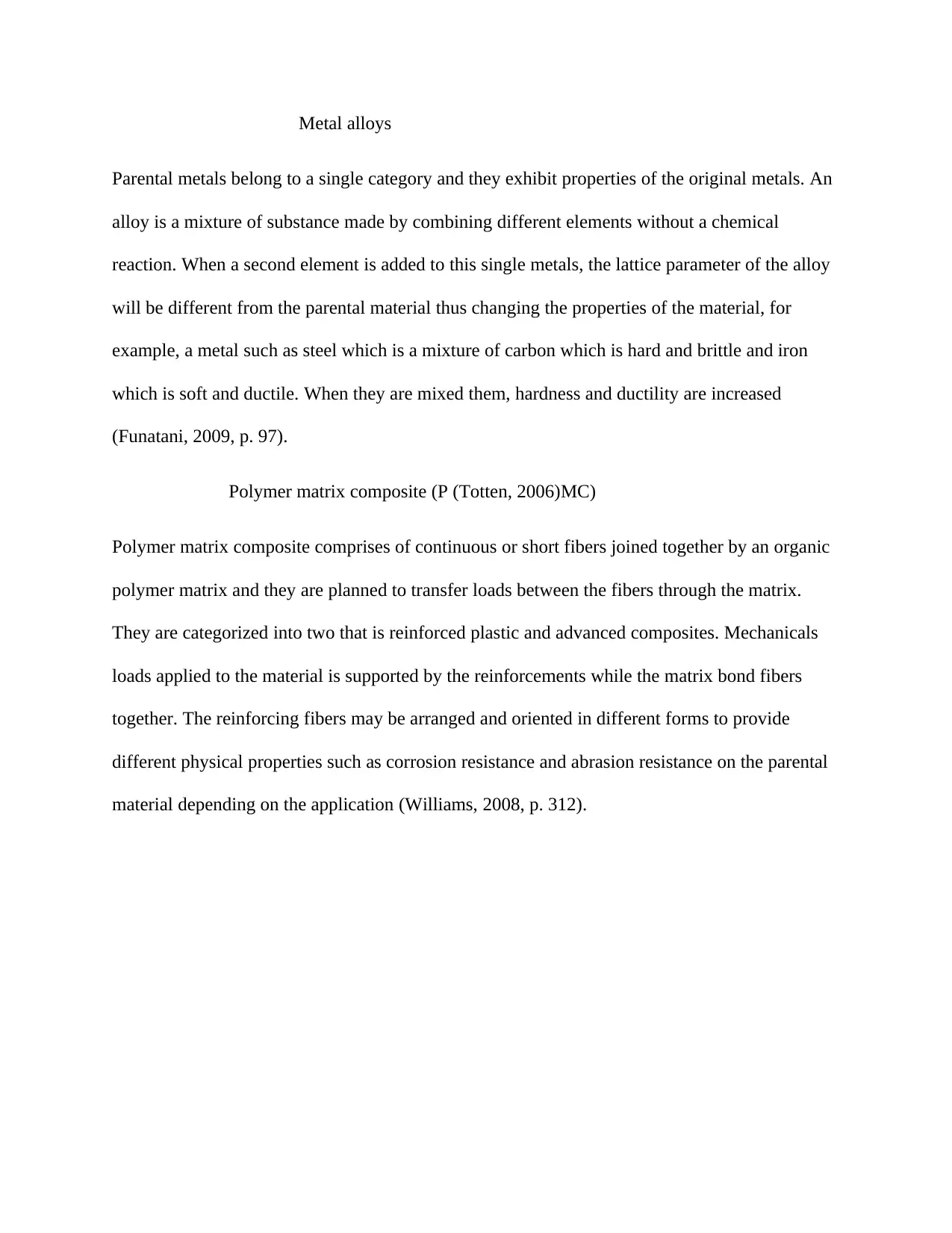
Metal alloys
Parental metals belong to a single category and they exhibit properties of the original metals. An
alloy is a mixture of substance made by combining different elements without a chemical
reaction. When a second element is added to this single metals, the lattice parameter of the alloy
will be different from the parental material thus changing the properties of the material, for
example, a metal such as steel which is a mixture of carbon which is hard and brittle and iron
which is soft and ductile. When they are mixed them, hardness and ductility are increased
(Funatani, 2009, p. 97).
Polymer matrix composite (P (Totten, 2006)MC)
Polymer matrix composite comprises of continuous or short fibers joined together by an organic
polymer matrix and they are planned to transfer loads between the fibers through the matrix.
They are categorized into two that is reinforced plastic and advanced composites. Mechanicals
loads applied to the material is supported by the reinforcements while the matrix bond fibers
together. The reinforcing fibers may be arranged and oriented in different forms to provide
different physical properties such as corrosion resistance and abrasion resistance on the parental
material depending on the application (Williams, 2008, p. 312).
Parental metals belong to a single category and they exhibit properties of the original metals. An
alloy is a mixture of substance made by combining different elements without a chemical
reaction. When a second element is added to this single metals, the lattice parameter of the alloy
will be different from the parental material thus changing the properties of the material, for
example, a metal such as steel which is a mixture of carbon which is hard and brittle and iron
which is soft and ductile. When they are mixed them, hardness and ductility are increased
(Funatani, 2009, p. 97).
Polymer matrix composite (P (Totten, 2006)MC)
Polymer matrix composite comprises of continuous or short fibers joined together by an organic
polymer matrix and they are planned to transfer loads between the fibers through the matrix.
They are categorized into two that is reinforced plastic and advanced composites. Mechanicals
loads applied to the material is supported by the reinforcements while the matrix bond fibers
together. The reinforcing fibers may be arranged and oriented in different forms to provide
different physical properties such as corrosion resistance and abrasion resistance on the parental
material depending on the application (Williams, 2008, p. 312).
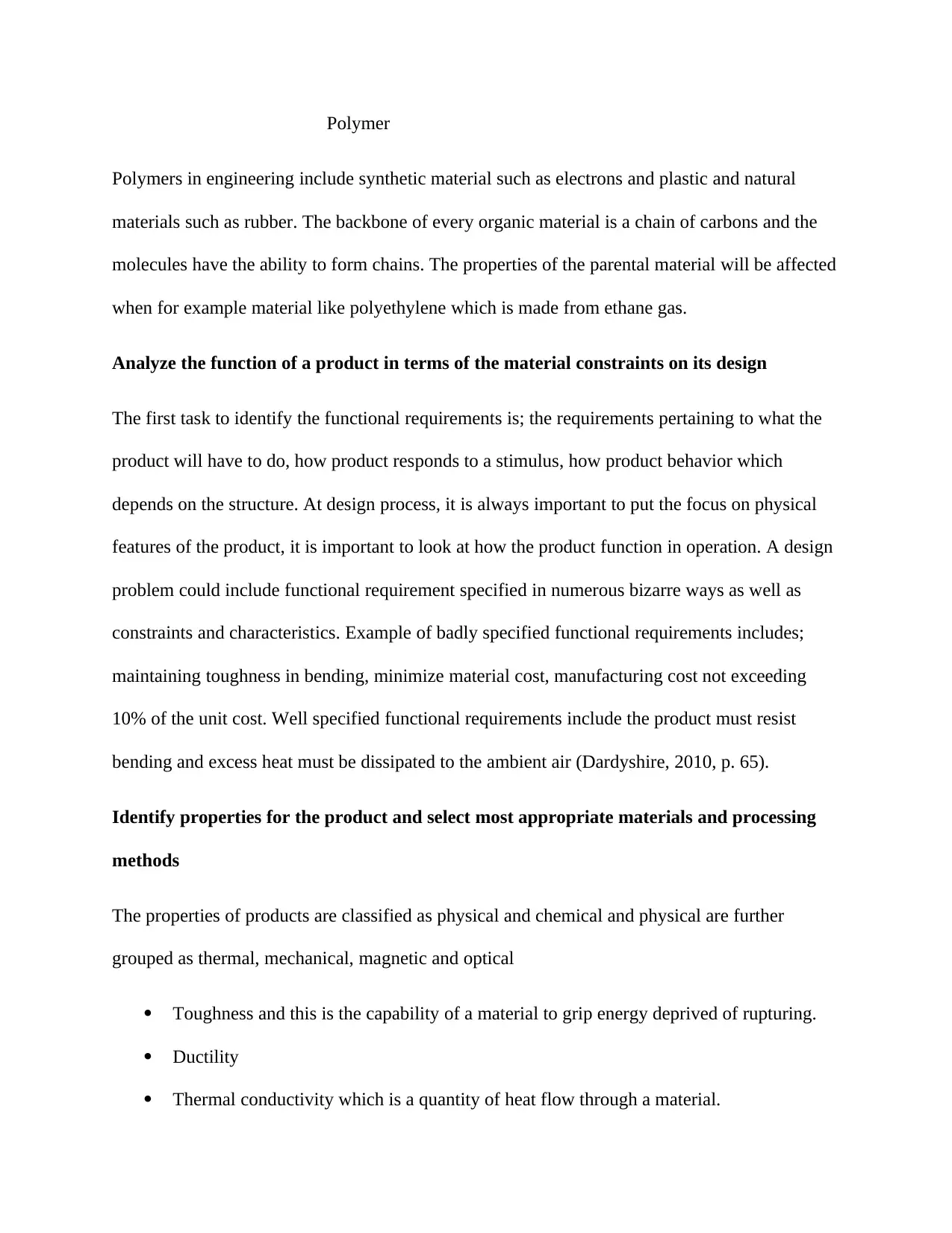
Polymer
Polymers in engineering include synthetic material such as electrons and plastic and natural
materials such as rubber. The backbone of every organic material is a chain of carbons and the
molecules have the ability to form chains. The properties of the parental material will be affected
when for example material like polyethylene which is made from ethane gas.
Analyze the function of a product in terms of the material constraints on its design
The first task to identify the functional requirements is; the requirements pertaining to what the
product will have to do, how product responds to a stimulus, how product behavior which
depends on the structure. At design process, it is always important to put the focus on physical
features of the product, it is important to look at how the product function in operation. A design
problem could include functional requirement specified in numerous bizarre ways as well as
constraints and characteristics. Example of badly specified functional requirements includes;
maintaining toughness in bending, minimize material cost, manufacturing cost not exceeding
10% of the unit cost. Well specified functional requirements include the product must resist
bending and excess heat must be dissipated to the ambient air (Dardyshire, 2010, p. 65).
Identify properties for the product and select most appropriate materials and processing
methods
The properties of products are classified as physical and chemical and physical are further
grouped as thermal, mechanical, magnetic and optical
Toughness and this is the capability of a material to grip energy deprived of rupturing.
Ductility
Thermal conductivity which is a quantity of heat flow through a material.
Polymers in engineering include synthetic material such as electrons and plastic and natural
materials such as rubber. The backbone of every organic material is a chain of carbons and the
molecules have the ability to form chains. The properties of the parental material will be affected
when for example material like polyethylene which is made from ethane gas.
Analyze the function of a product in terms of the material constraints on its design
The first task to identify the functional requirements is; the requirements pertaining to what the
product will have to do, how product responds to a stimulus, how product behavior which
depends on the structure. At design process, it is always important to put the focus on physical
features of the product, it is important to look at how the product function in operation. A design
problem could include functional requirement specified in numerous bizarre ways as well as
constraints and characteristics. Example of badly specified functional requirements includes;
maintaining toughness in bending, minimize material cost, manufacturing cost not exceeding
10% of the unit cost. Well specified functional requirements include the product must resist
bending and excess heat must be dissipated to the ambient air (Dardyshire, 2010, p. 65).
Identify properties for the product and select most appropriate materials and processing
methods
The properties of products are classified as physical and chemical and physical are further
grouped as thermal, mechanical, magnetic and optical
Toughness and this is the capability of a material to grip energy deprived of rupturing.
Ductility
Thermal conductivity which is a quantity of heat flow through a material.
Paraphrase This Document
Need a fresh take? Get an instant paraphrase of this document with our AI Paraphraser
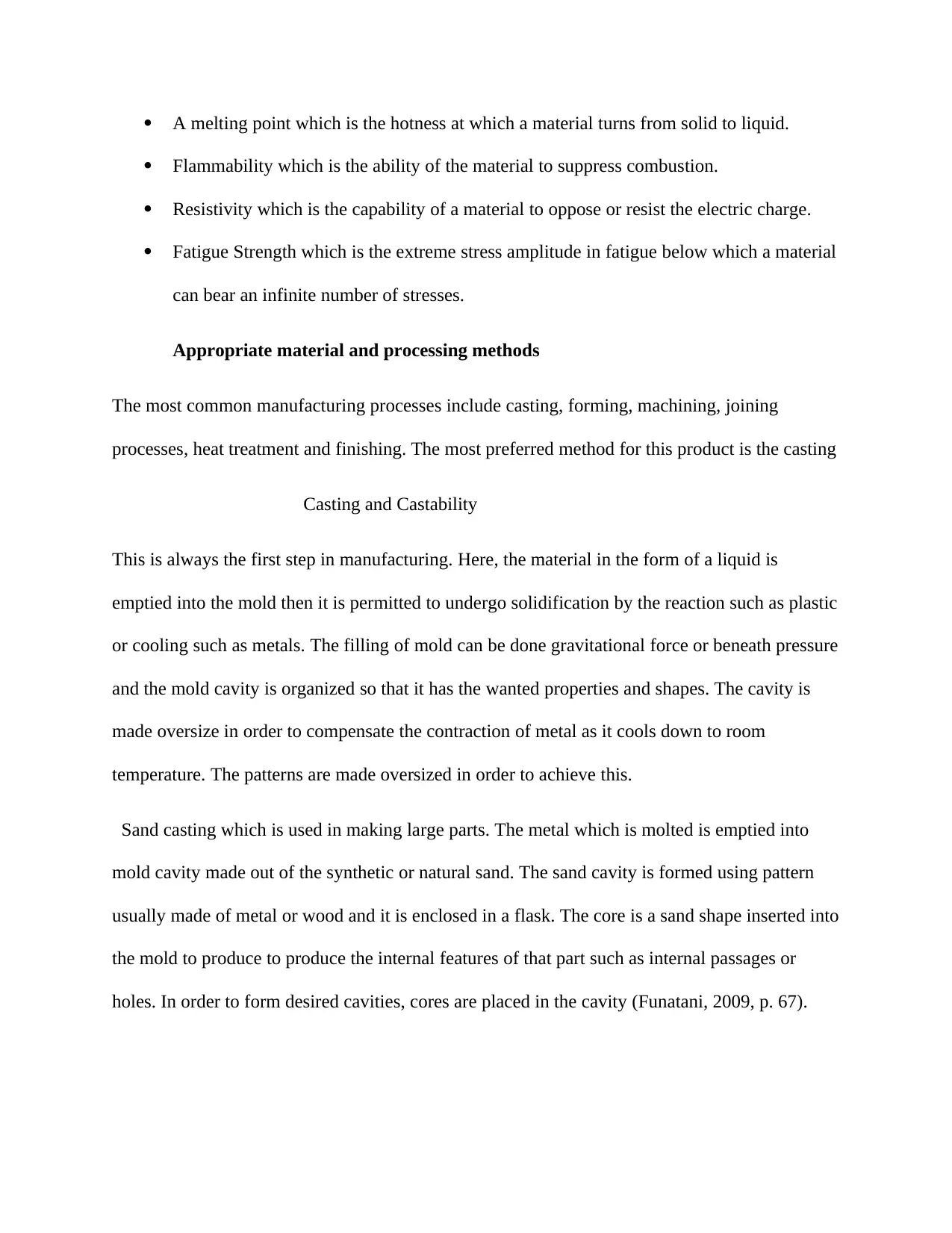
A melting point which is the hotness at which a material turns from solid to liquid.
Flammability which is the ability of the material to suppress combustion.
Resistivity which is the capability of a material to oppose or resist the electric charge.
Fatigue Strength which is the extreme stress amplitude in fatigue below which a material
can bear an infinite number of stresses.
Appropriate material and processing methods
The most common manufacturing processes include casting, forming, machining, joining
processes, heat treatment and finishing. The most preferred method for this product is the casting
Casting and Castability
This is always the first step in manufacturing. Here, the material in the form of a liquid is
emptied into the mold then it is permitted to undergo solidification by the reaction such as plastic
or cooling such as metals. The filling of mold can be done gravitational force or beneath pressure
and the mold cavity is organized so that it has the wanted properties and shapes. The cavity is
made oversize in order to compensate the contraction of metal as it cools down to room
temperature. The patterns are made oversized in order to achieve this.
Sand casting which is used in making large parts. The metal which is molted is emptied into
mold cavity made out of the synthetic or natural sand. The sand cavity is formed using pattern
usually made of metal or wood and it is enclosed in a flask. The core is a sand shape inserted into
the mold to produce to produce the internal features of that part such as internal passages or
holes. In order to form desired cavities, cores are placed in the cavity (Funatani, 2009, p. 67).
Flammability which is the ability of the material to suppress combustion.
Resistivity which is the capability of a material to oppose or resist the electric charge.
Fatigue Strength which is the extreme stress amplitude in fatigue below which a material
can bear an infinite number of stresses.
Appropriate material and processing methods
The most common manufacturing processes include casting, forming, machining, joining
processes, heat treatment and finishing. The most preferred method for this product is the casting
Casting and Castability
This is always the first step in manufacturing. Here, the material in the form of a liquid is
emptied into the mold then it is permitted to undergo solidification by the reaction such as plastic
or cooling such as metals. The filling of mold can be done gravitational force or beneath pressure
and the mold cavity is organized so that it has the wanted properties and shapes. The cavity is
made oversize in order to compensate the contraction of metal as it cools down to room
temperature. The patterns are made oversized in order to achieve this.
Sand casting which is used in making large parts. The metal which is molted is emptied into
mold cavity made out of the synthetic or natural sand. The sand cavity is formed using pattern
usually made of metal or wood and it is enclosed in a flask. The core is a sand shape inserted into
the mold to produce to produce the internal features of that part such as internal passages or
holes. In order to form desired cavities, cores are placed in the cavity (Funatani, 2009, p. 67).
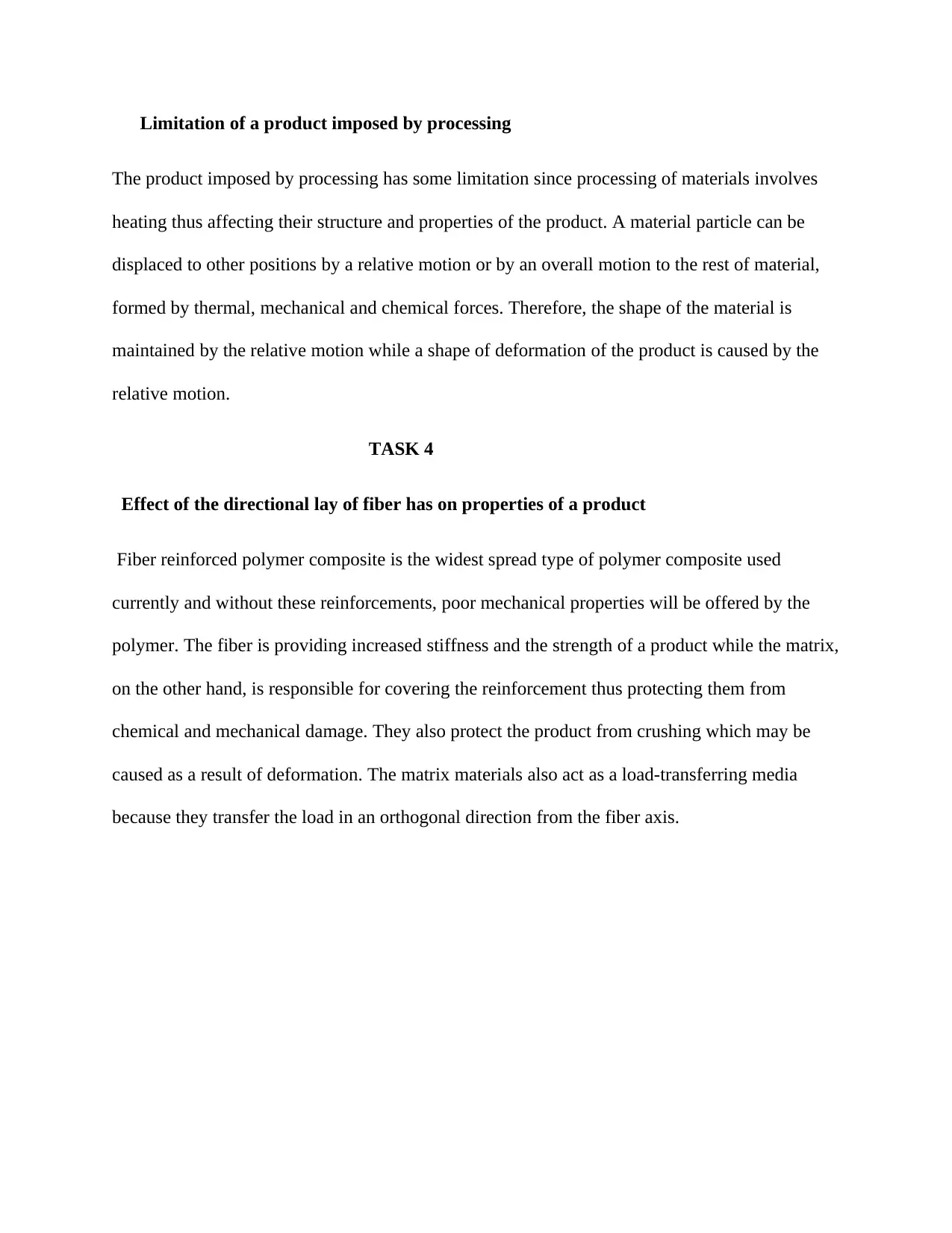
Limitation of a product imposed by processing
The product imposed by processing has some limitation since processing of materials involves
heating thus affecting their structure and properties of the product. A material particle can be
displaced to other positions by a relative motion or by an overall motion to the rest of material,
formed by thermal, mechanical and chemical forces. Therefore, the shape of the material is
maintained by the relative motion while a shape of deformation of the product is caused by the
relative motion.
TASK 4
Effect of the directional lay of fiber has on properties of a product
Fiber reinforced polymer composite is the widest spread type of polymer composite used
currently and without these reinforcements, poor mechanical properties will be offered by the
polymer. The fiber is providing increased stiffness and the strength of a product while the matrix,
on the other hand, is responsible for covering the reinforcement thus protecting them from
chemical and mechanical damage. They also protect the product from crushing which may be
caused as a result of deformation. The matrix materials also act as a load-transferring media
because they transfer the load in an orthogonal direction from the fiber axis.
The product imposed by processing has some limitation since processing of materials involves
heating thus affecting their structure and properties of the product. A material particle can be
displaced to other positions by a relative motion or by an overall motion to the rest of material,
formed by thermal, mechanical and chemical forces. Therefore, the shape of the material is
maintained by the relative motion while a shape of deformation of the product is caused by the
relative motion.
TASK 4
Effect of the directional lay of fiber has on properties of a product
Fiber reinforced polymer composite is the widest spread type of polymer composite used
currently and without these reinforcements, poor mechanical properties will be offered by the
polymer. The fiber is providing increased stiffness and the strength of a product while the matrix,
on the other hand, is responsible for covering the reinforcement thus protecting them from
chemical and mechanical damage. They also protect the product from crushing which may be
caused as a result of deformation. The matrix materials also act as a load-transferring media
because they transfer the load in an orthogonal direction from the fiber axis.
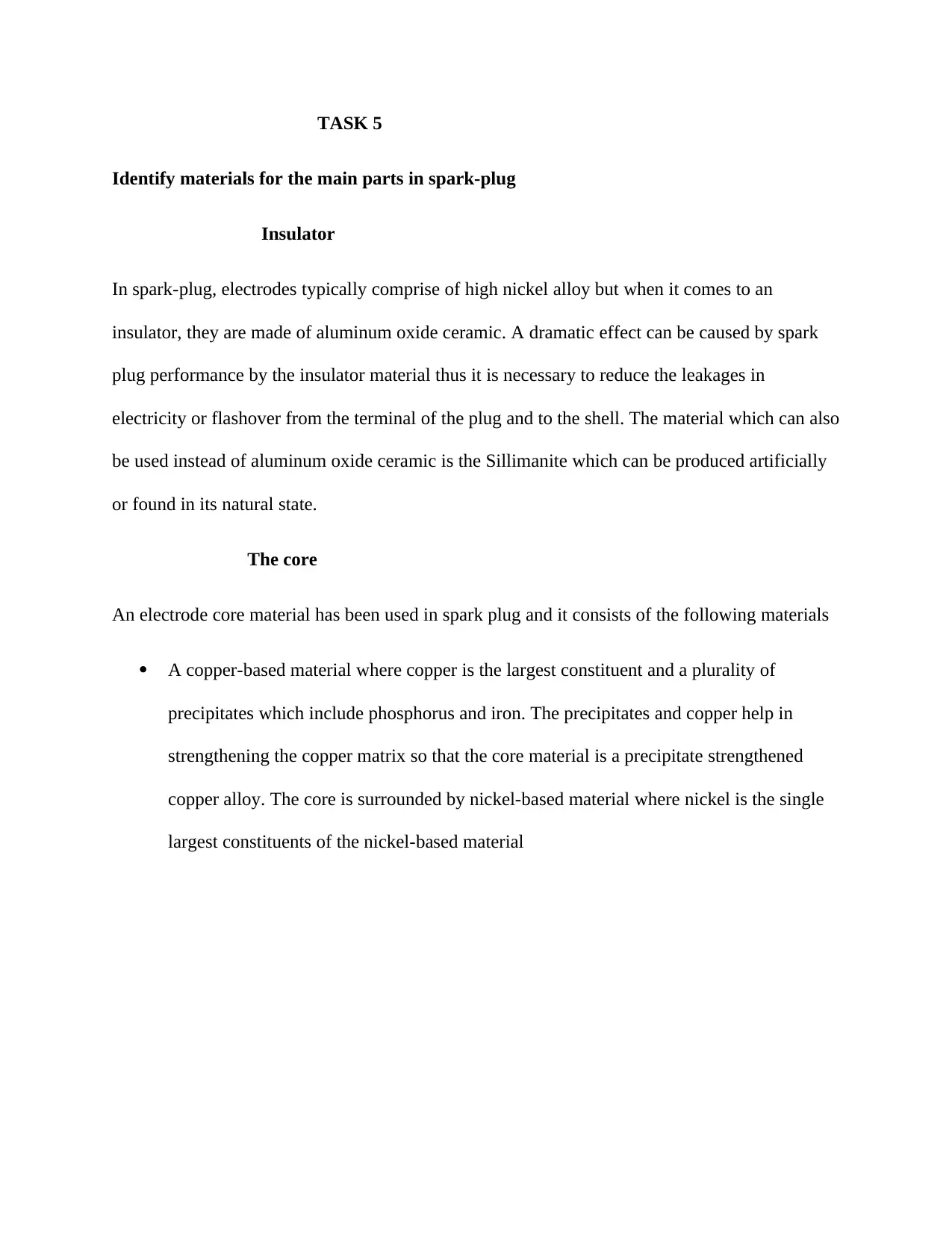
TASK 5
Identify materials for the main parts in spark-plug
Insulator
In spark-plug, electrodes typically comprise of high nickel alloy but when it comes to an
insulator, they are made of aluminum oxide ceramic. A dramatic effect can be caused by spark
plug performance by the insulator material thus it is necessary to reduce the leakages in
electricity or flashover from the terminal of the plug and to the shell. The material which can also
be used instead of aluminum oxide ceramic is the Sillimanite which can be produced artificially
or found in its natural state.
The core
An electrode core material has been used in spark plug and it consists of the following materials
A copper-based material where copper is the largest constituent and a plurality of
precipitates which include phosphorus and iron. The precipitates and copper help in
strengthening the copper matrix so that the core material is a precipitate strengthened
copper alloy. The core is surrounded by nickel-based material where nickel is the single
largest constituents of the nickel-based material
Identify materials for the main parts in spark-plug
Insulator
In spark-plug, electrodes typically comprise of high nickel alloy but when it comes to an
insulator, they are made of aluminum oxide ceramic. A dramatic effect can be caused by spark
plug performance by the insulator material thus it is necessary to reduce the leakages in
electricity or flashover from the terminal of the plug and to the shell. The material which can also
be used instead of aluminum oxide ceramic is the Sillimanite which can be produced artificially
or found in its natural state.
The core
An electrode core material has been used in spark plug and it consists of the following materials
A copper-based material where copper is the largest constituent and a plurality of
precipitates which include phosphorus and iron. The precipitates and copper help in
strengthening the copper matrix so that the core material is a precipitate strengthened
copper alloy. The core is surrounded by nickel-based material where nickel is the single
largest constituents of the nickel-based material
Secure Best Marks with AI Grader
Need help grading? Try our AI Grader for instant feedback on your assignments.
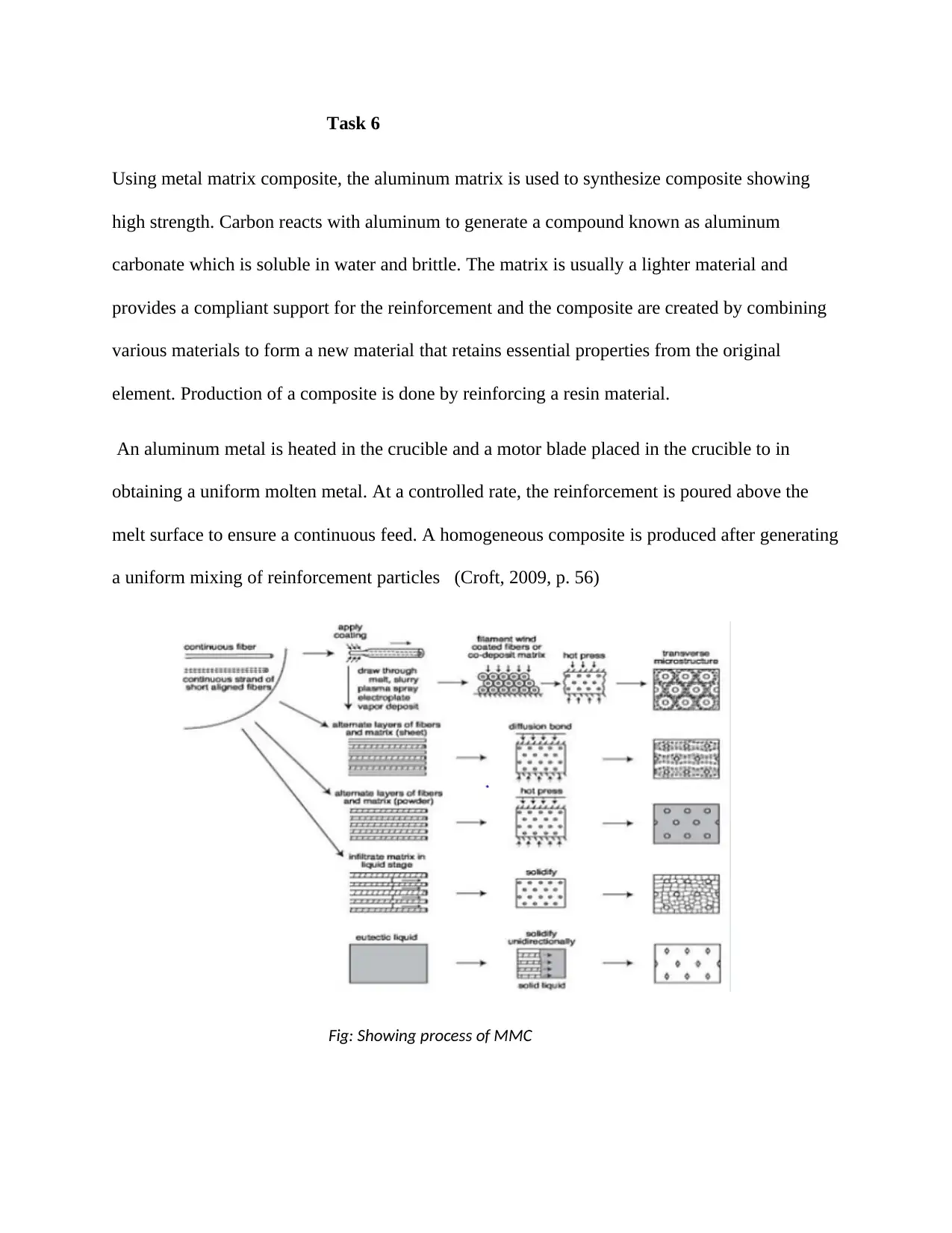
Task 6
Using metal matrix composite, the aluminum matrix is used to synthesize composite showing
high strength. Carbon reacts with aluminum to generate a compound known as aluminum
carbonate which is soluble in water and brittle. The matrix is usually a lighter material and
provides a compliant support for the reinforcement and the composite are created by combining
various materials to form a new material that retains essential properties from the original
element. Production of a composite is done by reinforcing a resin material.
An aluminum metal is heated in the crucible and a motor blade placed in the crucible to in
obtaining a uniform molten metal. At a controlled rate, the reinforcement is poured above the
melt surface to ensure a continuous feed. A homogeneous composite is produced after generating
a uniform mixing of reinforcement particles (Croft, 2009, p. 56)
Fig: Showing process of MMC
Using metal matrix composite, the aluminum matrix is used to synthesize composite showing
high strength. Carbon reacts with aluminum to generate a compound known as aluminum
carbonate which is soluble in water and brittle. The matrix is usually a lighter material and
provides a compliant support for the reinforcement and the composite are created by combining
various materials to form a new material that retains essential properties from the original
element. Production of a composite is done by reinforcing a resin material.
An aluminum metal is heated in the crucible and a motor blade placed in the crucible to in
obtaining a uniform molten metal. At a controlled rate, the reinforcement is poured above the
melt surface to ensure a continuous feed. A homogeneous composite is produced after generating
a uniform mixing of reinforcement particles (Croft, 2009, p. 56)
Fig: Showing process of MMC
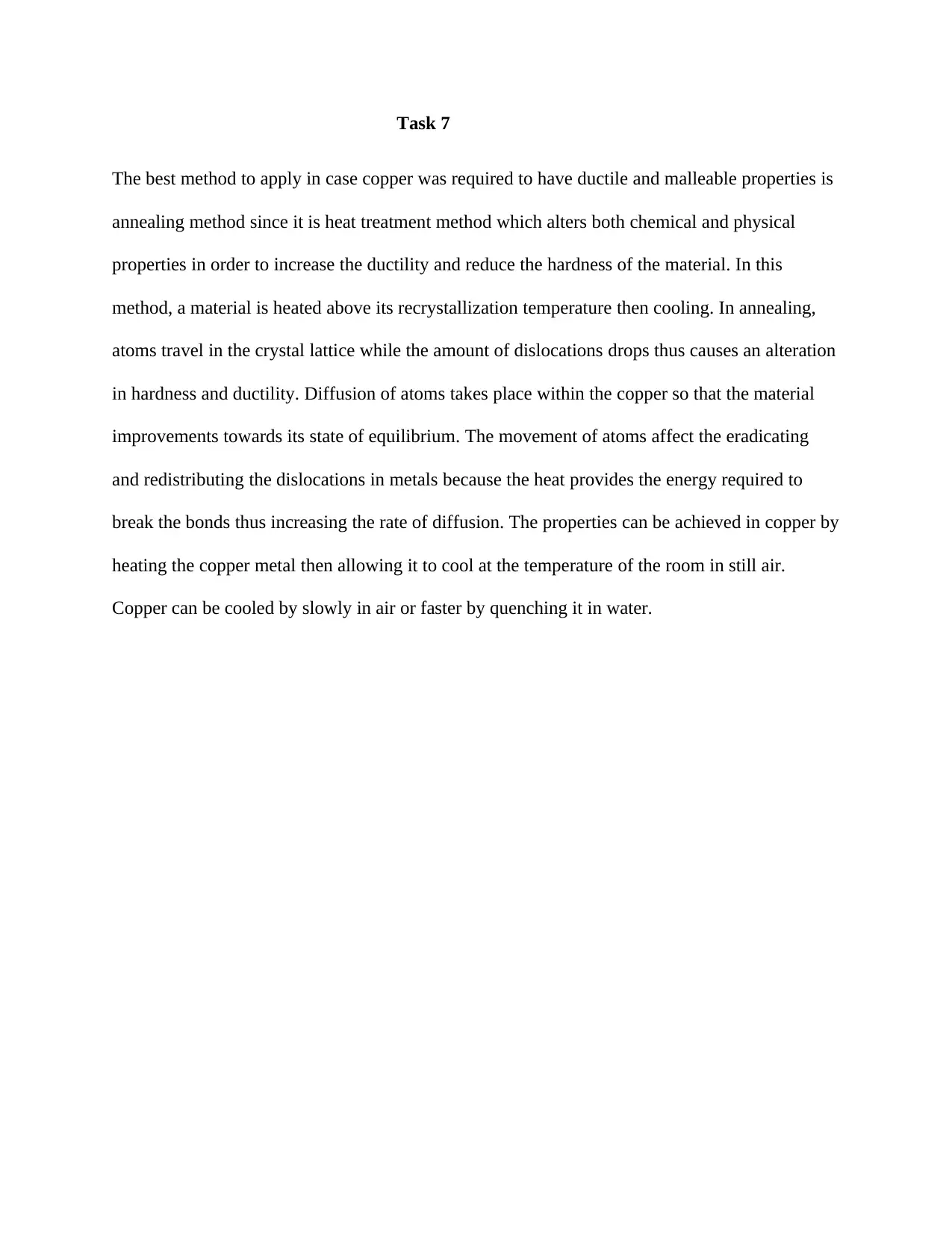
Task 7
The best method to apply in case copper was required to have ductile and malleable properties is
annealing method since it is heat treatment method which alters both chemical and physical
properties in order to increase the ductility and reduce the hardness of the material. In this
method, a material is heated above its recrystallization temperature then cooling. In annealing,
atoms travel in the crystal lattice while the amount of dislocations drops thus causes an alteration
in hardness and ductility. Diffusion of atoms takes place within the copper so that the material
improvements towards its state of equilibrium. The movement of atoms affect the eradicating
and redistributing the dislocations in metals because the heat provides the energy required to
break the bonds thus increasing the rate of diffusion. The properties can be achieved in copper by
heating the copper metal then allowing it to cool at the temperature of the room in still air.
Copper can be cooled by slowly in air or faster by quenching it in water.
The best method to apply in case copper was required to have ductile and malleable properties is
annealing method since it is heat treatment method which alters both chemical and physical
properties in order to increase the ductility and reduce the hardness of the material. In this
method, a material is heated above its recrystallization temperature then cooling. In annealing,
atoms travel in the crystal lattice while the amount of dislocations drops thus causes an alteration
in hardness and ductility. Diffusion of atoms takes place within the copper so that the material
improvements towards its state of equilibrium. The movement of atoms affect the eradicating
and redistributing the dislocations in metals because the heat provides the energy required to
break the bonds thus increasing the rate of diffusion. The properties can be achieved in copper by
heating the copper metal then allowing it to cool at the temperature of the room in still air.
Copper can be cooled by slowly in air or faster by quenching it in water.
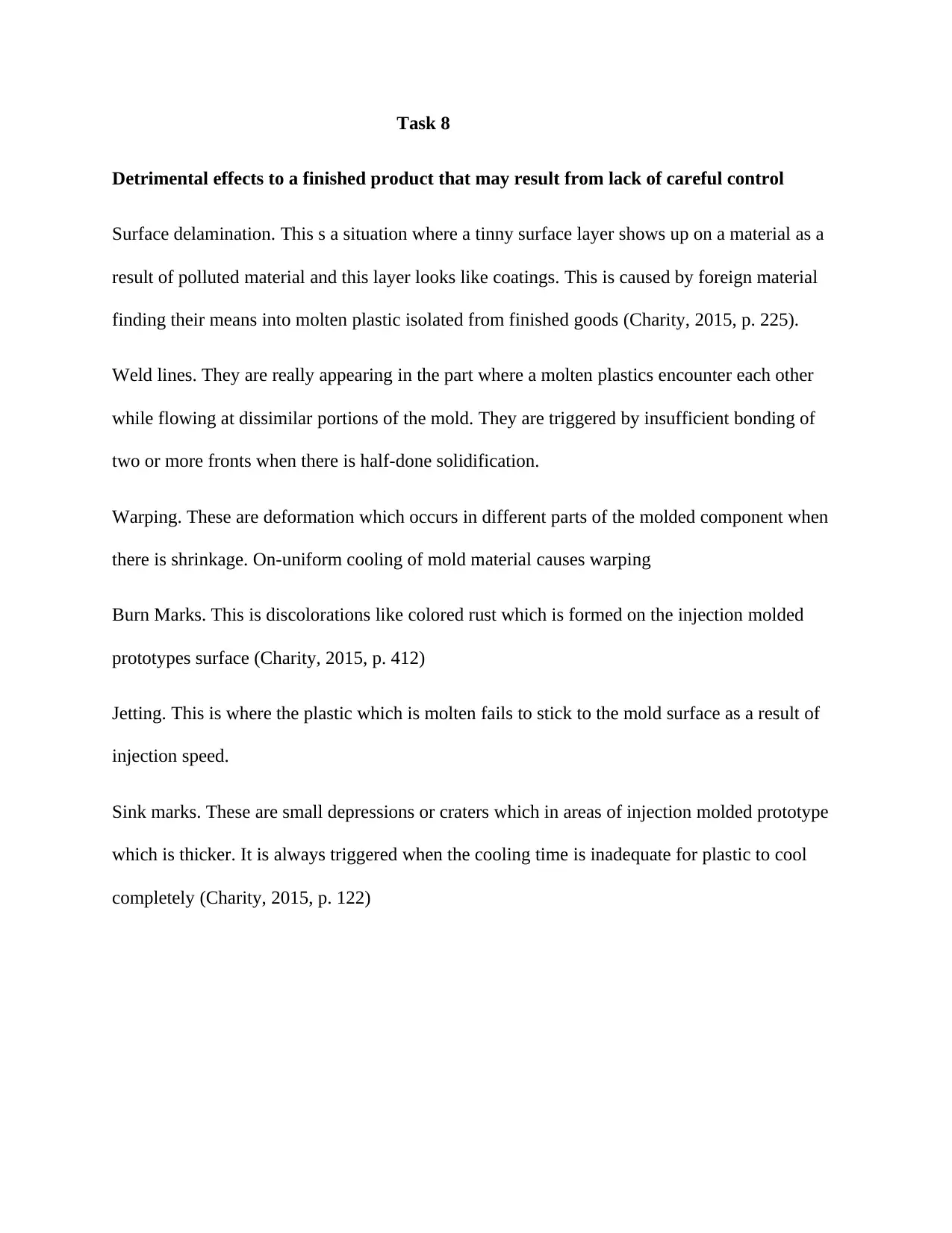
Task 8
Detrimental effects to a finished product that may result from lack of careful control
Surface delamination. This s a situation where a tinny surface layer shows up on a material as a
result of polluted material and this layer looks like coatings. This is caused by foreign material
finding their means into molten plastic isolated from finished goods (Charity, 2015, p. 225).
Weld lines. They are really appearing in the part where a molten plastics encounter each other
while flowing at dissimilar portions of the mold. They are triggered by insufficient bonding of
two or more fronts when there is half-done solidification.
Warping. These are deformation which occurs in different parts of the molded component when
there is shrinkage. On-uniform cooling of mold material causes warping
Burn Marks. This is discolorations like colored rust which is formed on the injection molded
prototypes surface (Charity, 2015, p. 412)
Jetting. This is where the plastic which is molten fails to stick to the mold surface as a result of
injection speed.
Sink marks. These are small depressions or craters which in areas of injection molded prototype
which is thicker. It is always triggered when the cooling time is inadequate for plastic to cool
completely (Charity, 2015, p. 122)
Detrimental effects to a finished product that may result from lack of careful control
Surface delamination. This s a situation where a tinny surface layer shows up on a material as a
result of polluted material and this layer looks like coatings. This is caused by foreign material
finding their means into molten plastic isolated from finished goods (Charity, 2015, p. 225).
Weld lines. They are really appearing in the part where a molten plastics encounter each other
while flowing at dissimilar portions of the mold. They are triggered by insufficient bonding of
two or more fronts when there is half-done solidification.
Warping. These are deformation which occurs in different parts of the molded component when
there is shrinkage. On-uniform cooling of mold material causes warping
Burn Marks. This is discolorations like colored rust which is formed on the injection molded
prototypes surface (Charity, 2015, p. 412)
Jetting. This is where the plastic which is molten fails to stick to the mold surface as a result of
injection speed.
Sink marks. These are small depressions or craters which in areas of injection molded prototype
which is thicker. It is always triggered when the cooling time is inadequate for plastic to cool
completely (Charity, 2015, p. 122)
Paraphrase This Document
Need a fresh take? Get an instant paraphrase of this document with our AI Paraphraser
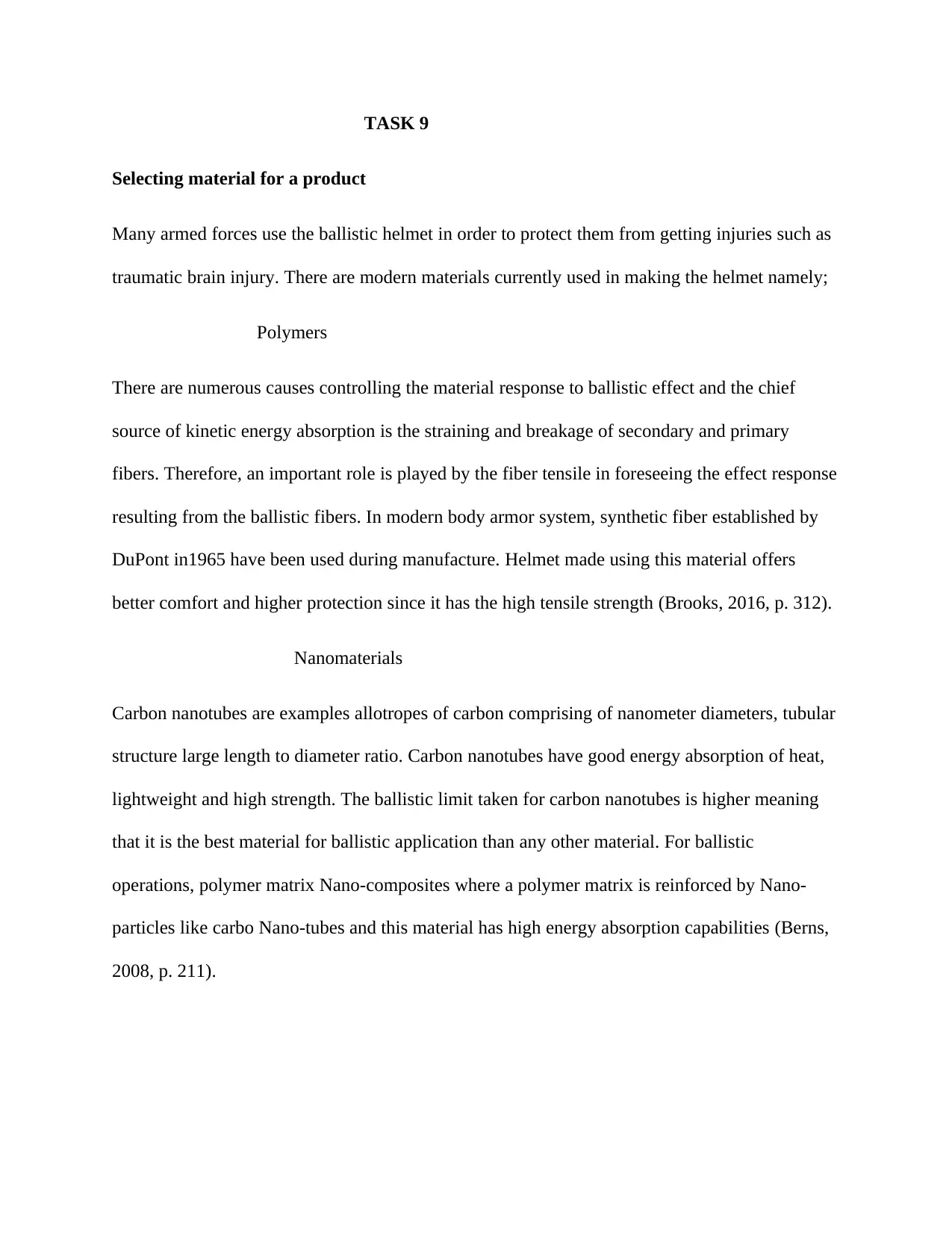
TASK 9
Selecting material for a product
Many armed forces use the ballistic helmet in order to protect them from getting injuries such as
traumatic brain injury. There are modern materials currently used in making the helmet namely;
Polymers
There are numerous causes controlling the material response to ballistic effect and the chief
source of kinetic energy absorption is the straining and breakage of secondary and primary
fibers. Therefore, an important role is played by the fiber tensile in foreseeing the effect response
resulting from the ballistic fibers. In modern body armor system, synthetic fiber established by
DuPont in1965 have been used during manufacture. Helmet made using this material offers
better comfort and higher protection since it has the high tensile strength (Brooks, 2016, p. 312).
Nanomaterials
Carbon nanotubes are examples allotropes of carbon comprising of nanometer diameters, tubular
structure large length to diameter ratio. Carbon nanotubes have good energy absorption of heat,
lightweight and high strength. The ballistic limit taken for carbon nanotubes is higher meaning
that it is the best material for ballistic application than any other material. For ballistic
operations, polymer matrix Nano-composites where a polymer matrix is reinforced by Nano-
particles like carbo Nano-tubes and this material has high energy absorption capabilities (Berns,
2008, p. 211).
Selecting material for a product
Many armed forces use the ballistic helmet in order to protect them from getting injuries such as
traumatic brain injury. There are modern materials currently used in making the helmet namely;
Polymers
There are numerous causes controlling the material response to ballistic effect and the chief
source of kinetic energy absorption is the straining and breakage of secondary and primary
fibers. Therefore, an important role is played by the fiber tensile in foreseeing the effect response
resulting from the ballistic fibers. In modern body armor system, synthetic fiber established by
DuPont in1965 have been used during manufacture. Helmet made using this material offers
better comfort and higher protection since it has the high tensile strength (Brooks, 2016, p. 312).
Nanomaterials
Carbon nanotubes are examples allotropes of carbon comprising of nanometer diameters, tubular
structure large length to diameter ratio. Carbon nanotubes have good energy absorption of heat,
lightweight and high strength. The ballistic limit taken for carbon nanotubes is higher meaning
that it is the best material for ballistic application than any other material. For ballistic
operations, polymer matrix Nano-composites where a polymer matrix is reinforced by Nano-
particles like carbo Nano-tubes and this material has high energy absorption capabilities (Berns,
2008, p. 211).
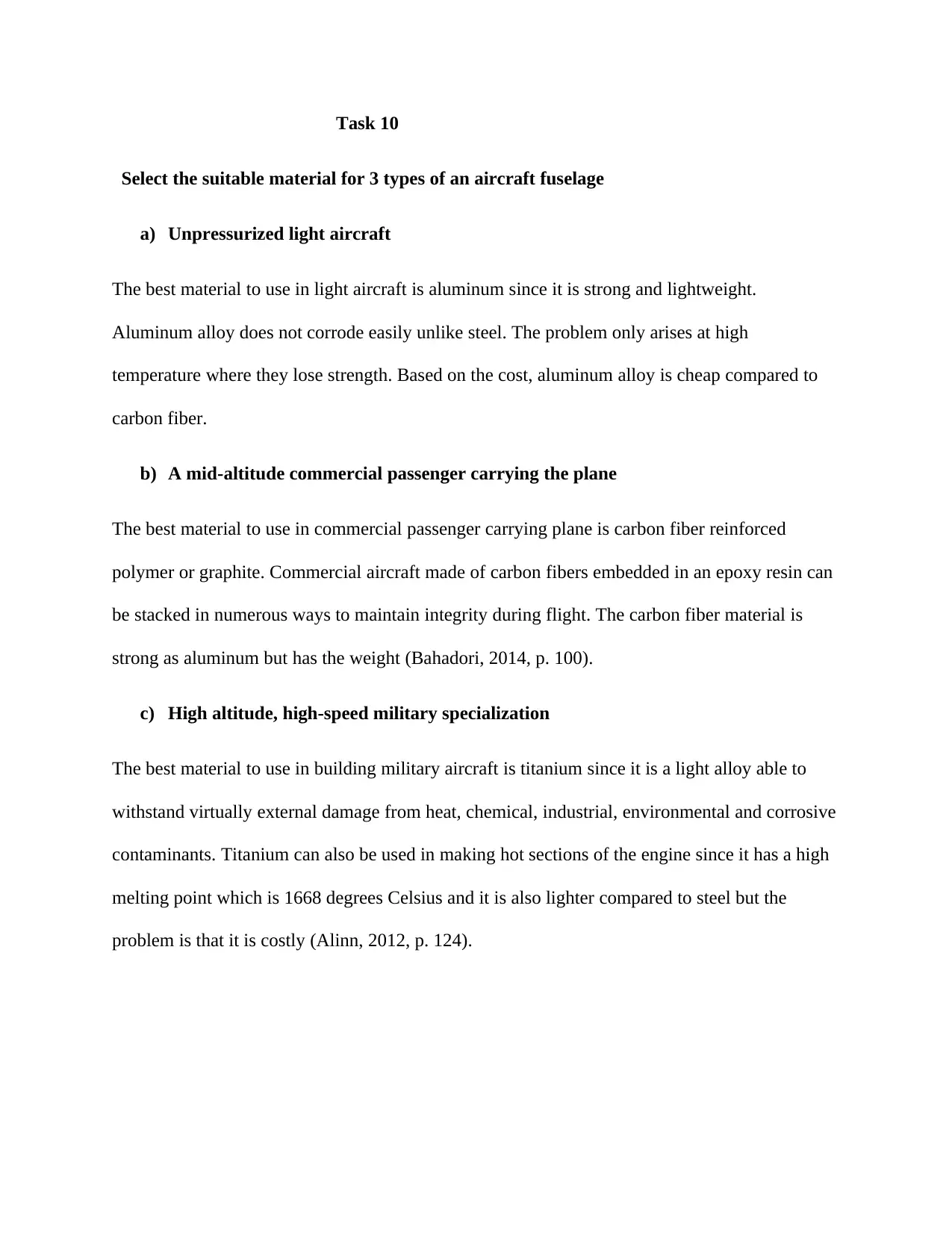
Task 10
Select the suitable material for 3 types of an aircraft fuselage
a) Unpressurized light aircraft
The best material to use in light aircraft is aluminum since it is strong and lightweight.
Aluminum alloy does not corrode easily unlike steel. The problem only arises at high
temperature where they lose strength. Based on the cost, aluminum alloy is cheap compared to
carbon fiber.
b) A mid-altitude commercial passenger carrying the plane
The best material to use in commercial passenger carrying plane is carbon fiber reinforced
polymer or graphite. Commercial aircraft made of carbon fibers embedded in an epoxy resin can
be stacked in numerous ways to maintain integrity during flight. The carbon fiber material is
strong as aluminum but has the weight (Bahadori, 2014, p. 100).
c) High altitude, high-speed military specialization
The best material to use in building military aircraft is titanium since it is a light alloy able to
withstand virtually external damage from heat, chemical, industrial, environmental and corrosive
contaminants. Titanium can also be used in making hot sections of the engine since it has a high
melting point which is 1668 degrees Celsius and it is also lighter compared to steel but the
problem is that it is costly (Alinn, 2012, p. 124).
Select the suitable material for 3 types of an aircraft fuselage
a) Unpressurized light aircraft
The best material to use in light aircraft is aluminum since it is strong and lightweight.
Aluminum alloy does not corrode easily unlike steel. The problem only arises at high
temperature where they lose strength. Based on the cost, aluminum alloy is cheap compared to
carbon fiber.
b) A mid-altitude commercial passenger carrying the plane
The best material to use in commercial passenger carrying plane is carbon fiber reinforced
polymer or graphite. Commercial aircraft made of carbon fibers embedded in an epoxy resin can
be stacked in numerous ways to maintain integrity during flight. The carbon fiber material is
strong as aluminum but has the weight (Bahadori, 2014, p. 100).
c) High altitude, high-speed military specialization
The best material to use in building military aircraft is titanium since it is a light alloy able to
withstand virtually external damage from heat, chemical, industrial, environmental and corrosive
contaminants. Titanium can also be used in making hot sections of the engine since it has a high
melting point which is 1668 degrees Celsius and it is also lighter compared to steel but the
problem is that it is costly (Alinn, 2012, p. 124).
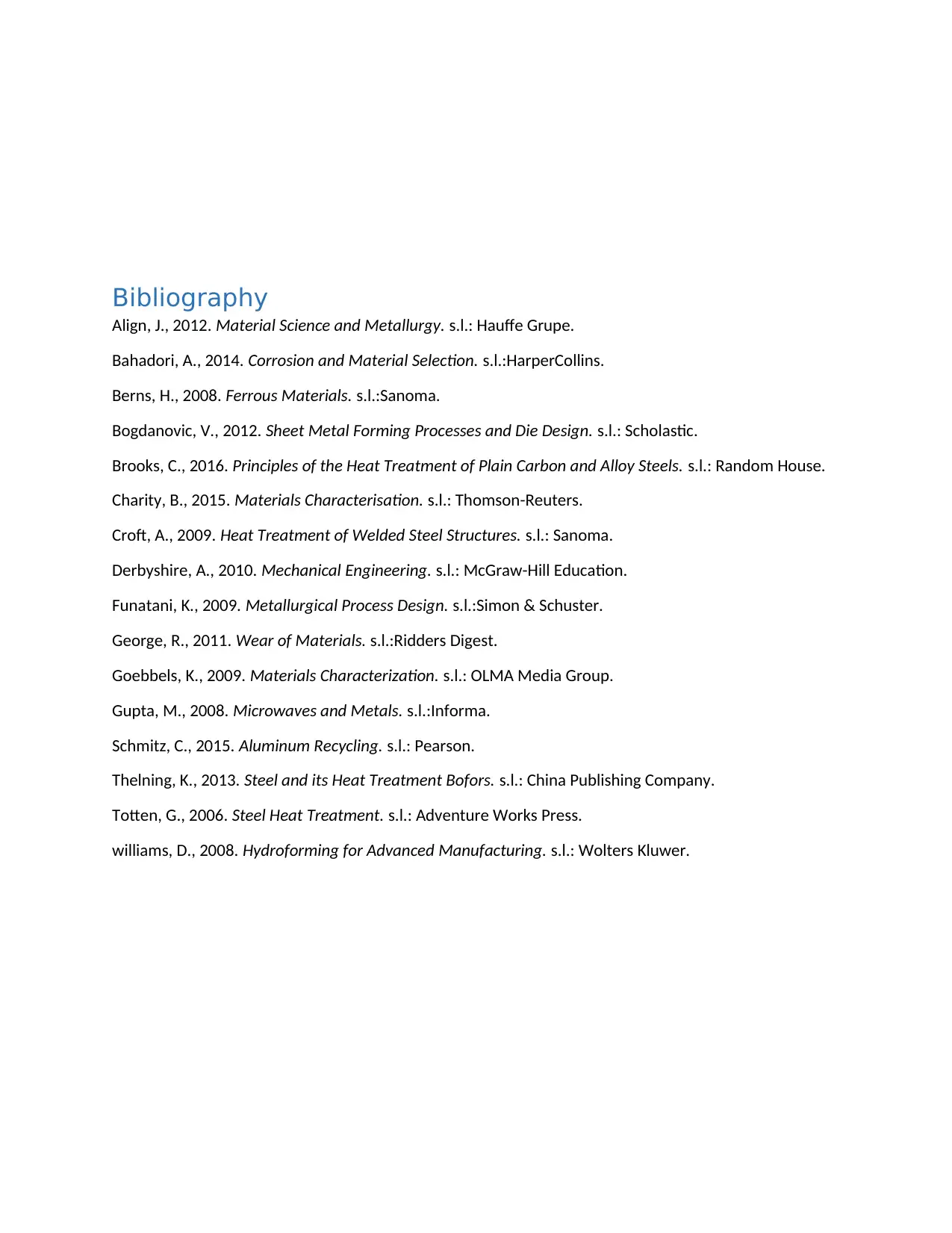
Bibliography
Align, J., 2012. Material Science and Metallurgy. s.l.: Hauffe Grupe.
Bahadori, A., 2014. Corrosion and Material Selection. s.l.:HarperCollins.
Berns, H., 2008. Ferrous Materials. s.l.:Sanoma.
Bogdanovic, V., 2012. Sheet Metal Forming Processes and Die Design. s.l.: Scholastic.
Brooks, C., 2016. Principles of the Heat Treatment of Plain Carbon and Alloy Steels. s.l.: Random House.
Charity, B., 2015. Materials Characterisation. s.l.: Thomson-Reuters.
Croft, A., 2009. Heat Treatment of Welded Steel Structures. s.l.: Sanoma.
Derbyshire, A., 2010. Mechanical Engineering. s.l.: McGraw-Hill Education.
Funatani, K., 2009. Metallurgical Process Design. s.l.:Simon & Schuster.
George, R., 2011. Wear of Materials. s.l.:Ridders Digest.
Goebbels, K., 2009. Materials Characterization. s.l.: OLMA Media Group.
Gupta, M., 2008. Microwaves and Metals. s.l.:Informa.
Schmitz, C., 2015. Aluminum Recycling. s.l.: Pearson.
Thelning, K., 2013. Steel and its Heat Treatment Bofors. s.l.: China Publishing Company.
Totten, G., 2006. Steel Heat Treatment. s.l.: Adventure Works Press.
williams, D., 2008. Hydroforming for Advanced Manufacturing. s.l.: Wolters Kluwer.
Align, J., 2012. Material Science and Metallurgy. s.l.: Hauffe Grupe.
Bahadori, A., 2014. Corrosion and Material Selection. s.l.:HarperCollins.
Berns, H., 2008. Ferrous Materials. s.l.:Sanoma.
Bogdanovic, V., 2012. Sheet Metal Forming Processes and Die Design. s.l.: Scholastic.
Brooks, C., 2016. Principles of the Heat Treatment of Plain Carbon and Alloy Steels. s.l.: Random House.
Charity, B., 2015. Materials Characterisation. s.l.: Thomson-Reuters.
Croft, A., 2009. Heat Treatment of Welded Steel Structures. s.l.: Sanoma.
Derbyshire, A., 2010. Mechanical Engineering. s.l.: McGraw-Hill Education.
Funatani, K., 2009. Metallurgical Process Design. s.l.:Simon & Schuster.
George, R., 2011. Wear of Materials. s.l.:Ridders Digest.
Goebbels, K., 2009. Materials Characterization. s.l.: OLMA Media Group.
Gupta, M., 2008. Microwaves and Metals. s.l.:Informa.
Schmitz, C., 2015. Aluminum Recycling. s.l.: Pearson.
Thelning, K., 2013. Steel and its Heat Treatment Bofors. s.l.: China Publishing Company.
Totten, G., 2006. Steel Heat Treatment. s.l.: Adventure Works Press.
williams, D., 2008. Hydroforming for Advanced Manufacturing. s.l.: Wolters Kluwer.
1 out of 16
Related Documents
Your All-in-One AI-Powered Toolkit for Academic Success.
+13062052269
info@desklib.com
Available 24*7 on WhatsApp / Email
![[object Object]](/_next/static/media/star-bottom.7253800d.svg)
Unlock your academic potential
© 2024 | Zucol Services PVT LTD | All rights reserved.





